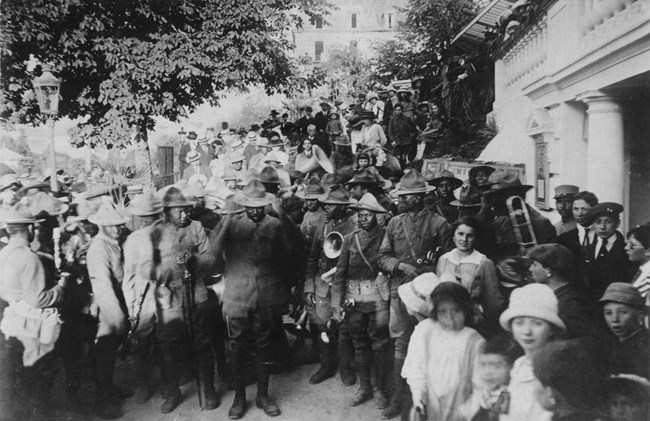Last updated: January 7, 2022
Article
Corporal Morris Link: Harlem Hell-fighter, buried at St. Paul's

Corporal Morris Link: Harlem Hell-fighter, buried at St. Paul’s
Morris D. Link, who is buried in the historic cemetery at St. Paul’s Church National Historic Site, served with a remarkable American unit in World War I -- the 369th New York Infantry. Nicknamed the Harlem Hellfighters, this all-black regiment fought with the French army against the Germans on the Western front in some of the war’s fiercest fighting, and earned broad praise for their military abilities at a time of extreme prejudice in American society.
One of the unit’s earliest volunteers, Link was born in North Carolina in 1883, and moved to Mt. Vernon in the early 20th century. In 1910, along with his wife Lizzie, also a North Carolina native, the future Hellfighter was living on South Seventh Avenue, employed as a teamster, or driver of teams of horses transporting goods. The couple had no children.
The infantry regiment, originally called the 15th New York, was raised in upper Manhattan’s Harlem neighborhood, a center of the city’s African American community. Black recruits from other parts of metropolitan New York, including Link, also joined. The regiment entered Federal service July 25, 1917, only three months after the United States entered the Great War, and trained in South Carolina, experiencing discrimination from the local community and other Army units. In Europe, the men were assigned labor service, instead of combat training. Another instance of racial prejudice of the early20th century, this exclusion from the opportunity to fight was a point of extreme frustration for the New Yorkers.
In April 1918, reconstituted as the 369th, they were welcomed as combat troops into the French army, which had a broader understanding of effective military service across racial and ethnic lines. The army incorporated units from other nationalities that were part of the French empire, including Algerian and Moroccan troops. The New Yorkers were issued French weapons, helmets and brown leather belts and pouches, although they continued to wear American uniforms.
Early on the morning of July 15, 1918, the 369th came under heavy artillery bombardment, part of the Second Battle of the Marne, as the French struggled to hold off a German offensive. The shells fell with particular ferocity on the front line trenches, which were held by Company K. Corporal Link was among four soldiers killed in the action. His body was nearly obliterated, but a search of the remains discovered a fragment of a book. The Mt. Vernon resident was posthumously awarded the Croix de Guerre, the French War Cross, an honor eventually extended to the entire regiment.
Originally interred in a French military cemetery, Link’s remains were returned to the United States three years later, and were brought back to Mt. Vernon for final burial. His widow Elizabeth, city officials, a military band and firing squad were part of a large crowd attending a memorial service at the Centennial A.M.E. Zion church, on October 12, 1921. Burial followed in the City section of the St. Paul’s cemetery, Link’s final resting place, where his grave is memorialized through a veterans’ stone.
The corporal from the 369th was one of 85 Mt. Vernon soldiers who made the supreme sacrifice during World War I. The city planted trees in honor of each of the fallen, and the sapling commemorating Link was based on Wallace Avenue at the intersection with Westchester Avenue.
